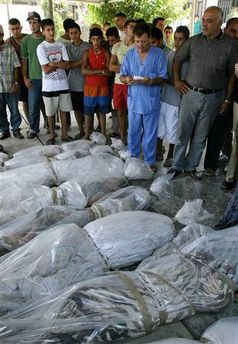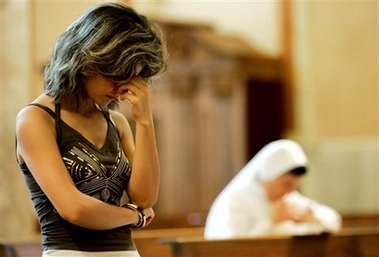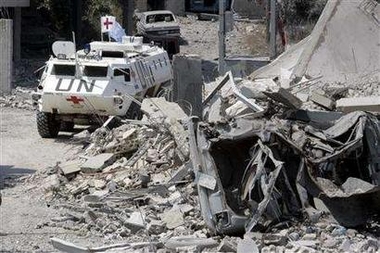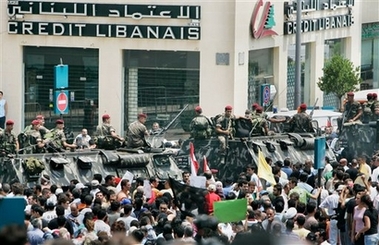 DAY 19, Beirut- An Israeli raid Sunday on a building sheltering civilians in a village east of Tyre killed 51 Lebanese, leading to calls for an immediate truce in the fighting between Israel and Hezbollah guerrillas and causing US Secretary of State Condoleezza Rice to cancel a scheduled visit to Beirut.
DAY 19, Beirut- An Israeli raid Sunday on a building sheltering civilians in a village east of Tyre killed 51 Lebanese, leading to calls for an immediate truce in the fighting between Israel and Hezbollah guerrillas and causing US Secretary of State Condoleezza Rice to cancel a scheduled visit to Beirut.
Lebanese Prime Minister Fouad Seniora and House Speaker Nabih Berri said after the number of casualties became known that ‘there will be no negotiations with Israel until there is an immediate and unconditional ceasefire.’ Seniora also later called for an emergency meeting of the United Nation Security Council to discuss an end to the violence. Sunday’s death toll in the bombing at Qana was the highest in any single incident since the fighting between Israel and Hezbollah guerrillas began on July 12.’Fifty-one Lebanese civilians were killed, among them 27 children, also we have 17 wounded,’ a hospital source in Tyre said. The building hit Sunday was housing refugees in the village of Qana, east of Tyre. An Israeli artillery strike which hit the same village in 1996 killed 109 people and forced Israel to suspend its ‘Grapes of Wrath’ operation against Hezbollah. TO VIIEW THE PICTURES PLS CLICK READ MORE and also NEWS ARCHIVE for previous days.
A Lebanese Christian woman prays in the St. George Cathedral in downtown Beirut, Lebanon, during Sunday morning church services, July 30, 2006. An Israeli strike that devastated a building in Qana killed at least 56 people, including at least 34 children, putting the total Lebanese death toll from the Israeli campaign at more than 500, the Lebanese Red Cross said. (AP Photo/Kevork Djansezian)
A Lebanese Christian man prays in the St. George Cathedral in downtown Beirut, Lebanon, during Sunday morning church services, July 30, 2006. An Israeli strike that devastated a building in Qana killed at least 56 people, including at least 34 children, putting the total Lebanese death toll from the Israeli campaign at more than 500, the Lebanese Red Cross said. (AP Photo/Kevork Djansezian)
A member of the Red Cross checks bodies after an Israeli air raid in Qana, 6km from the port city of Tyre (Soure), in south Lebanon July 30, 2006. The Israeli air strike in Qana killed at least 54 people, the deadliest attack in an onslaught against Hizbollah that has largely overshadowed an Israeli offensive in the Gaza Strip. REUTERS/Zohra Bensemra (LEBANON)
An Israeli resident of Kiryat Shmona looks at the damage caused by a rocket on a car near the Israel –Lebanon border July 30, 2006. REUTERS/Carlos Barria (ISRAEL)
Red Cross members are seen after an Israeli air raid in Qana, 6 kilometers (4 miles) from the port city of Tyre in south Lebanon, July 30, 2006. (Zohra Bensemra/Reuters)
Rescuers line up bodies outside the Tyre hospital after an Israeli air raid on Qana killed more than 54 people, 37 of them children, in south Lebanon, July 30, 2006. (Ali Hashisho/Reuters)
Broken glass is seen at the entrance of the United Nations headquarters during a protest in Beirut July 30, 2006. Lebanese protesters broke into the United Nations headquarters in Beirut on Sunday, smashing windows and ransacking offices, after an Israeli air strike killed at least 40 people in south Lebanon. (Mohamed Azakir/Reuters)
A U.N armoured car is parked near rubble after an Israeli air raid in Qana, 6 km (4 miles) from the port-city of Tyre (Soure), in south Lebanon, July 30, 2006. REUTERS/Zohra Bensemra
Hezbollah and The Shiite Amal movement allied to the Hezbollah supporters furious over an Israeli airstrike in Qana that killed up to 50 refugees, smash one the car convoy of the Chief of the Lebanese Police Ashraf Rifi at the entrance of the Government Palace, after he was checking the United Nations building in Beirut, Lebanon Sunday, July 30, 2006. Thousands of Hezbollah supporters, many burning U.S. and U.N. flags, scaled fences, smashed bulletproof glass, and thew rocks at the UN building before storming through barriers and entering the ground floor of the building itself.(AP Photo/Hussein Malla)

A civil defense worker carries the body of Lebanese child recovered from the rubble of a demolished building that was struck by an Israeli airstrike at the village of Qana near the southern Lebanon city of Tyre, Sunday, July 30, 2006. Israeli missiles struck this southern Lebanese village early Sunday, flattening houses on top of sleeping residents. The Lebanese Red Cross said the airstrike, in which at least 34 children were killed, pushed the overall Lebanese death toll to more than 500. (AP Photo/Nasser Nasser)
Supporters of Hezbollah and the Shiite Amal movement allied to the Hezbollah furious over an Israeli airstrike in Qana that killed up to 50 refugees, smash the car of the Chief of the Lebanese Police Ashraf Rifi in Beirut, Lebanon Sunday, July 30, 2006 after around 5,000 protesters massed outside the empty UN building, chanting anti-American and anti-Israeli slogans. Dozens of angry demonstrators, carrying yellow flags of the militant Hezbollah group and chanting ‘we are all resistance,’ climbed over the two-meter high fence outside the U.N. office in downtown Beirut. They then broke glass and burnt a U.N. flag. A few protesters managed to break into the building and damage some of its offices. (AP Photo/Hussein Malla)
A demonstrator holding a Lebanese flag shouts anti- Israel and U.S. slogans during a protest against Israeli air strikes, in front of the U.N. office in Amman July 30, 2006. An Israeli air strike killed 54 Lebanese civilians, including 37 children, on Sunday, prompting Lebanon to tell U.S. Secretary of State Condoleezza Rice she was unwelcome in Beirut before a ceasefire. REUTERS/Ali Jarekji (JORDAN)

Hezbollah supporters furious over an Israeli airstrike in Qana that killed up to 50 refugees, one carrying a Lebanese flag, smash through glass as they storm their way into the main United Nations building in Beirut, Lebanon Sunday, July 30, 2006. Thousands of Hezbollah supporters, many burning U.S. and U.N. flags, scaled fences, smashed bulletproof glass, and threw rocks at the building before storming through barriers and entering the ground floor of the building itself. (AP Photo/Ben
A Lebanese family walks along a road damaged by an Israeli attack near the Lebanon– Syria border gate July 30, 2006. REUTERS/Morteza Nikoubazl (LEBANON)
Hezbollah supporters furious over an Israeli airstrike in Qana that killed up to 50 refugees, carrying portraits of Hezbollah leader Sheik Hassan Nasrallah, smash through glass as they storm their way into the main United Nations building in Beirut, Lebanon Sunday, July 30, 2006. Thousands of Hezbollah supporters, many burning U.S. and U.N. flags, scaled fences, smashed bulletproof glass, and threw rocks at the building before storming through barriers and entering the ground floor of the building itself. (AP Photo/Hussein Malla)
Hezbollah supporters angry over an Israeli air strike in Qana that killed up to 50 refugees, smash through glass with rocks as they storm their way into the main United Nations building in Beirut, Lebanon Sunday, July 30, 2006. Thousands of Hezbollah supporters, many burning U.S. and U.N. flags, scaled fences, smashed bulletproof glass, and thew rocks at the building before storming through barriers and entering the ground floor of the building itself. (AP Photo/Ben Curtis)
Lebanese Army soldiers in armoured vehicles arrive to police a demonstration after Hezbollah supporters, furious over an Israeli air strike in Qana that killed up to 50 refugees, stormed their way into the main United Nations building in Beirut, Lebanon Sunday, July 30, 2006. Thousands of Hezbollah supporters, many burning U.S. and U.N. flags, scaled fences, smashed bulletproof glass, and threw rocks at the building before storming through barriers and entering the ground floor of the building itself. (AP Photo/Ben Curtis)
A Lebanese Red Cross volunteer rushes to the rubble of a demolished building that was struck by Israeli war plane missiles at the village of Qana near the southern Lebanon city of Tyre, Sunday, July 30, 2006. Dozens of civilians, including at least 20 children, were killed Sunday in an Israeli airstrike that flattened houses in this southern Lebanon village _ the deadliest attack in 19 days of fighting. (AP Photo/Lefteris Pitarakis)
A Lebanese Civil Defence officer holds a piece of a missile, found in the rubble of a demolished building that was struck by Israeli war plane missiles at the village of Qana near the southern Lebanon city of Tyre, Sunday July 30, 2006. The fragment except various number codes, has a writing in English: ‘FOR USE ON MK-84 GUIDED BOMB BSU-37/B.’ Dozens of civilians, including at least 20 children, were killed Sunday in an Israeli airstrike that flattened houses in this southern Lebanon village _ the deadliest attack in 19 days of fighting. (AP Photo/Lefteris Pitarakis)
A United Nations armoured personnel carrier converted into an ambulance drives past a destroyed mosque as it arrives at the village of Qana near the southern Lebanon city of Tyre, Sunday, July 30, 2006. Dozens of civilians, including at least 20 children, were killed Sunday in an Israeli airstrike that flattened houses in this southern Lebanon village _ the deadliest attack in 19 days of fighting. (AP Photo/Lefteris Pitarakis)
Pope Benedict XVI waves to the faithful during the Angelus prayer from his summer residence in Castel Gandolfo, south of Rome, July 30, 2006. Pope Benedict called for an immediate ceasefire between Israeli forces and Hizbollah guerrillas in southern Lebanon on Sunday after an Israeli air strike killed at least 40 Lebanese civilians. REUTERS/Alessandro Bianchi (ITALY)
A Lebanese man wearing a T-shirt with a picture of Hezbollah leader Sheik Hassan Nasrallah, walks past a crater, followed by others, at a road between the Lebanese and the Syrian checkpoints, 300 meters (yards) beyond a Lebanese customs post, at the Masnaa crossing, in the eastern Bekaa Valley, Lebanon, Sunday, July 30, 2006, after Israeli warplanes fired three missiles Saturday closing the road. Israeli missiles that landed near a Lebanese border post at the main Syria –Lebanon crossing closed the border between the two countries for the first time in the 18-day-old conflict, police officials said. (AP Photo/Samer Husseini)
The bodies of Lebanese people recovered under the rubble of a demolished building that was struck by Israeli war plane missiles at the village of Qana near the southern Lebanon city of Tyre, are seen Sunday July 30, 2006. Dozens of civilians, including at least 20 children, were killed Sunday in an Israeli airstrike that flattened houses in this southern Lebanon village _ the deadliest attack in 19 days of fighting. (AP Photo/Lefteris Pitarakis)
Rice, who arrived in the region Saturday night, told a news conference in Jerusalem after the raid that she would not proceed to the Lebanese capital as originally planned, but would instead continue her talks with Israeli leaders to try work out a ceasefire to end the 18-day-old violence.
‘My work towards a ceasefire is really here today,’ she said.
Some Lebanese, mainly Hezbollah followers, fanned into the streets Sunday shortly after they heard and saw the pictures of the Qana incident.
In the Lebanese capital hundreds of angry demonstrators, many waving Hezbollah flags, stormed the UN building in downtown Beirut, breaking glass and smashing the elevators.
The demonstrators later marched on the US Embassy east of Beirut, but Lebanese police had cordoned off the area surrounding the heavily-guarded embassy building.
Witnesses at Qana said most of the dead were women and children. and the residential area had been targeted by fifty shells since dawn.
‘I can say this is a massacre. Most of the people here have fled other areas to hide from the Israeli bombardment from other areas in southern Lebanon,’ a Red cross volunteer at the scene told dpa.
‘This is the same scene I saw in 1996 … at least 20 children are among the dead,’ a witness told dpa.
Several hours after the Qana raid Israel renewed airstrikes on southern Lebanon, killing five more civilians.
The 19th day of the fighting between Israel and Hezbollah had begun with the Israel Air Force bombing Lebanon and the Iranian-backed guerrilla group launching missiles at northern Israeli towns.
An army spokeswoman said the air force flew over 40 raids overnight, and over 20 during the day, bombing 10 structures used by Hezbollah and attacking roads used by the guerrillas to move their missiles.
Hezbollah had fired around 80 rockets at northern Israel by mid- afternoon.
Israel also widened its ground offensive, sending troops into the village of Taibe, near the border. An army spokeswoman said in the morning that a combined Israeli force of infantry and armour had crossed into Lebanon to carry out ‘pin-point’ operations.
Israel has said its aims in the fighting include having the Lebanese army deploy in the south, bolstered by an international force, significantly weakening Hezbollah’s military ability and leading to the release of two Israeli soldiers abducted by Hezbollah on June 12 during a cross-border raid.
The incident sparked Israel’s major offensive against Hezbollah and other targets in Lebanon.
More than 500 Lebanese, the vast majority of them civilians, have been killed in the more than 2,500 air raids Israel has carried out since the offensive started, or by artillery and naval shelling. More than 1200 people have been wounded.
Lebanese Health Minister Mohammed Khalifeh told dpa that he feared the death toll would reach 750 as a result of the Qana bombing.
‘The death toll may increase because we believe a lot of casualties are still buried under the rubble and our volunteers are unable to retrieve their bodies due to intensity of the shelling in their areas,’ he said.
Some 18 Israeli civilians have been killed by the close to 1600 missiles Hezbollah has launched at Israel, and 33 soldiers have been killed in the fighting. Hundreds more people have been wounded.























